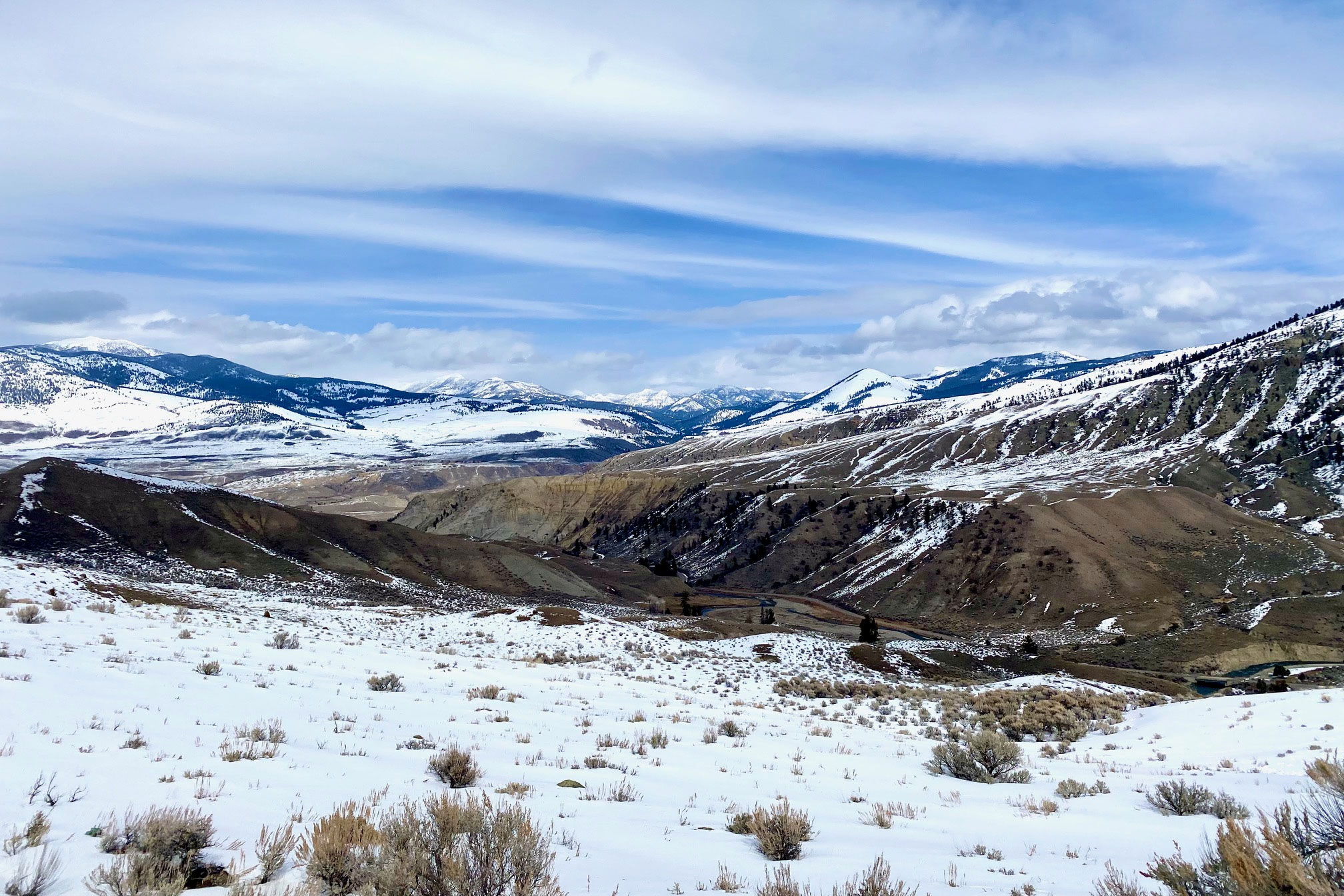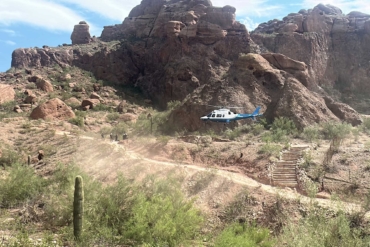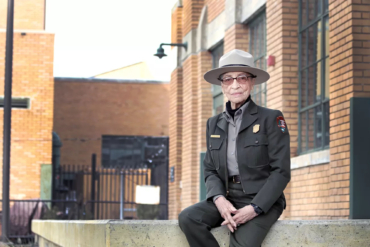America’s first National Park, Yellowstone National Park, conjures images of the untouched Old West, with graceful valleys with herds of bison, elk, and pronghorn underneath the big western sky. Except in the summer, when thousands and thousands of people descend on the park, clogging up the roadways and surrounding wildlife for selfies. Throngs of tourists flood the walkways, fill the visitors’ centers, and file along the hiking trails.
But with good timing and cooperative weather, visitors can enjoy Yellowstone without those teeming crowds. On a recent visit in March, I saw more animals than people. But the hiking trails were knee-deep in snow. Which got me wondering: Where and when could you hike in Yellowstone without both the snow and all the humans?
I asked an expert to find out. Natalie Sawley has been leading tours for Backcountry Safaris in Yellowstone National Park for 3 years. Armed with a degree in animal science, she has a wealth of knowledge about Yellowstone hiking trails and the animals that make the park their home.
Sawley loves hiking in Yellowstone. Even though she leads tours 6 days a week, she said she often returns to the park on her days off to take a hike. There are over 100 hiking trails in Yellowstone — Sawley shared some of her favorites with GearJunkie. They range from short day hikes to longer hikes, and even full-day outings.
But the real trick is hitting these trails when no one else is on them. Which also means timing your Yellowstone National Park visit right.
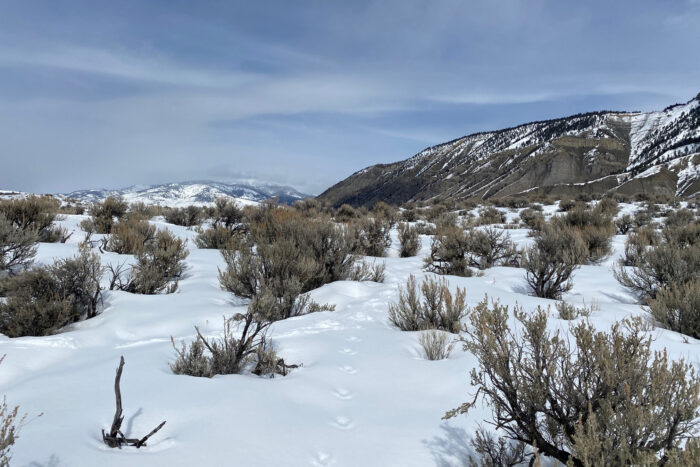
When to Visit Yellowstone Without the Crowds
Ideal Months
The best months for hiking in relative solitude in Yellowstone are June and September — the bookends of the Yellowstone season. Kids are either at the tail end of the school year or they’ve just returned, so families are less frequently encountered. And the weather is phenomenal in either month.
The five entrances to Yellowstone open at the end of May each year, making the park accessible both from the two Wyoming entrances and the three on the Montana side.
Even in May, you can still run into snow on the hiking trails, but by June most of it is melted. Some trails in May are closed for bears because, typically, that’s around when mama bears and their cubs wake up from hibernation. And when they do, they are both very hungry and very grumpy. It’s not safe for people to get too close to their dens. By June, the risk lowers significantly.
Winter starts in Yellowstone around mid-October. So by September, the weather is already starting to cool down, and the colors of the foliage start changing. It’s a beautiful time to visit Yellowstone, though most visitors shy away from the cooler temperatures. That means that most of the hiking trails (and many campsites) are vacant.
And without snow or hibernating bears, it’s also one of the safest times to hike.
Less Ideal Months
If you must visit Yellowstone during the most popular months of July and August, you can still avoid some of the crowds. You’ve just got to put the work in. Hike a mile or more on any of the trails and you will leave about 90% of other visitors behind.
Most people tend to stick to the main road. Many never even leave their cars. It might be a slog of car traffic to get to the trailhead in the summer. But once you get out hiking, the grandiosity of the park will be more or less all yours — most of the time.
Sawley suggests getting either an early start or a late one if you are intent on avoiding people. In midsummer, the sun has fully risen by 6:30 a.m., and you can get a good long hike in before noon. Or you can start later, around 4 p.m., and still have lots of light for hiking without encountering many people.
“The park feels a lot more personal because it’s just you and nature,” Sawley said of hiking in Yellowstone. “It’s your experience, not an experience you shared with 1,000 other people.”

Short and Easy Hikes in Yellowstone National Park
The more casual the hike, the more people you’re bound to encounter on the trail. But sometimes, you don’t want to take a 5-10-mile slog out into the woods. Sometimes, you just want a gentle nature walk by some waterfalls or around a lake. Here are Sawley’s favorite shorter hikes she frequents in Yellowstone National Park.
Fairy Falls
This easy, flat 1.6-mile hike features an overlook of Grand Prismatic, one of several natural hot springs in Yellowstone. Fairy Falls trail is closed in the spring because there are several known bear dens close to the trail. They need some extra space as they wake up from hibernation.
The falls themselves are some of the most impressive in Yellowstone, at over 200 feet tall. And if you hike another 0.6 miles past them, you’ll reach Spray and Imperial Geysers.
There are two trailheads and two different approaches to reach Fairy Falls. One starts at the parking lot at the end of Fountain Flat Drive. The other is 1 mile south of Midway Geyser Basin at the Fairy Falls Parking Lot.
Trout Lake Loop
A gentle 1.2-mile hike around Trout Lake is popular with hikers, backpackers, and anglers. (So, you are likely to see more people on this trail. But the views of the lake are suburb.)
Rim Trail From Uncle Tom’s to Artist Point
Park at the Artist Point trailhead and hike for 0.5 miles until you reach Uncle Tom’s trail. The steep descent takes you close to the rim of the lower falls for a spectacular view. The hike out and back is 2 miles long with 325 feet of elevation change.
The trail is just south of the Yellowstone Education Visitor’s Center and the Yellowstone River.
Mystic Falls
The trailhead for Mystic Falls is just 3 miles from Old Faithful — so, it’s in one of the busiest parts of the park. But cross the Biscuit Basin boardwalk and follow the trail paralleling the Little Firehole River, and you’ll leave the crowds behind you. Stay on the trail, and watch closely for hydrothermal areas.
Continue hiking for a total of 2.4 miles, winding through the mixed conifer forest and climbing 225 feet. The 70-foot Mystic Falls will be on your left.
At the end of the trail at the waterfall is a campground that’s popular with backpackers. But in June and September, you’re less likely to encounter a lot of them and might even be able to score a campsite without too much trouble.
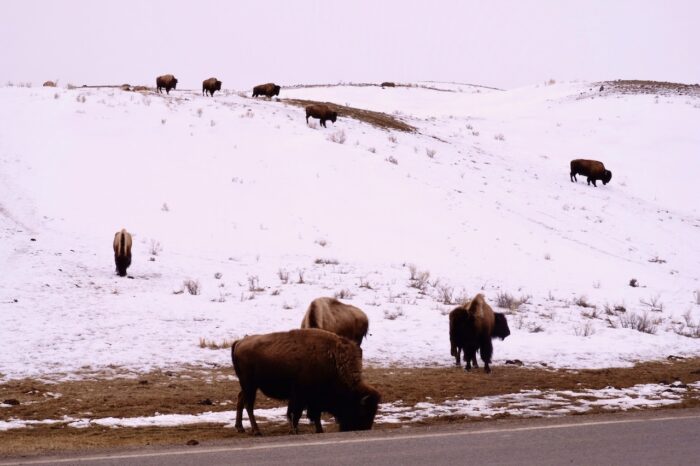
Longer, More Challenging Hikes in Yellowstone National Park
Harder hikes that cover longer distances will naturally repel a lot of casual visitors. You’ll likely encounter more wildlife as a result. And the deeper into the wilderness you get, the fewer hikers you’ll find. These are several that Sawley recommended.
Slough Creek
Like most trails in Yellowstone, Slough Creek is an out-and-back trail with a total length of 3.4 miles. Sawley said this is a fantastic spot to see wildlife like resident bison, elk, pronghorn (often mistaken for antelope, but which are actually in the giraffe family), big horn sheep, and, if you’re lucky, maybe you’ll spot a bear, wolf, or mountain lion.
This trail follows a historic wagon route into the Absaroka-Beartooth Wilderness outside of Yellowstone. It starts with a semi-steep climb and a short descent into a series of meadows. Then you reach Slough Creek, itself — a nice fishing area and place to relax.
Lamar Valley Trail
7 miles will go quickly when hiking through the storied Lamar Valley. This is a popular trail with hikers and backpackers alike, so if you’re trying to avoid crowds, make sure you visit in early June or late September. Or, if you’re there in midsummer, try and hike early or late in the day, as Sawley recommended.
The trail is considered moderate difficulty and has an elevation gain of about 700 feet. You top out at around 7,025 feet with sweeping views of the Lamar River Valley and surrounding mountains.
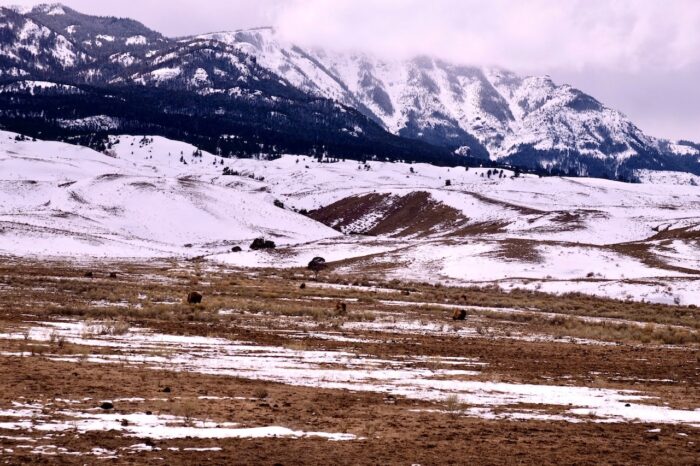
Blacktail Deer Creek Trail
The Blacktail Deer Creek Trail is a moderately challenging and delightfully unpopular 7-mile hike, out and back through grassy open areas and Douglas fir forest. Horseback riders enjoy the wide-open, mostly gentle trail.
Blacktail Deer Creek Trail ends at a suspension bridge that spans the Yellowstone River. You can continue past it, crossing the river to check out Cervice Lake to the north. Either way, you take the same trail back to the trailhead where you parked.
Yellowstone Natural Bridge
The 3.1-mile out-and-back Yellowstone National Bridge trail is relatively short and only climbs 216 feet. The route starts at Bridge Bay Marina on the western edge of Yellowstone Lake. It winds west, eventually crossing the aptly named Bridge Creek before hikers reach the Natural Bridge — a 51-foot rock formation spanning the creek.
This trail is closed in early summer so bears can feed on Bridge Creek’s spawning trout. So this is one that’s best hiked in the later part of the season, closer to September to best avoid crowds.
Elephant Back Mountain
The 800-foot climb up Elephant Back Mountain rewards hikers with a panoramic view of Yellowstone Lake and the surrounding valley. The 3.6-mile loop is challenging. It takes hikers through dense lodgepole pine forests all the way to the top.

More Pro Tips for Hiking in Yellowstone National Park
- Always carry water with you. There are no water stations at any of the trailheads in the park. Make sure you fill up at visitors’ centers or campgrounds with wells.
- Wear layers. In the western U.S. mountains, rain and snow can come out of nowhere and then disappear just as quickly. Even if the weather catches you off guard, don’t let it catch you unprepared. Pack the necessary gear.
- Be bear-aware and don’t hike alone. Carry bear spray. Sawley said that bear bells are not effective and suggested talking loudly or singing while hiking, instead. She emphasized that hikers should sound like a human. Do not mimic animal sounds.
- Dogs are not allowed anywhere in Yellowstone. So sadly, your canine companions have to stay at home.
- Never run from wildlife. The animals will consider you a threat or a challenge if you try to flee from them. Be quiet and slowly back away from an animal if you have a close encounter — unless you see a mountain lion, in which case Sawley said you should yell loudly and make yourself as big as humanly possible.
- Avoid wildlife that’s in your way. If an animal has hunkered down in the middle of the trail you’re on, quietly turn around and take another trail. Do not attempt to pass any wildlife on a Yellowstone hiking trail. Even docile-seeming animals like deer or bison have been known to harm people who get too close or surprise them.
- Be mindful of your surroundings. Believe it or not, bison can sneak up on you, even though they are huge animals that weigh an average of 2,000 pounds. Never get closer than 10 feet to a bison. Stay alert out there.
For more information on hiking trails, trail closures, park information, permitting and camping info, and more, visit the Yellowstone National Park website.
